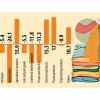Prices of garments shipped to US, EU see a decline

In recent months, Bangladesh's garment shipments to major markets such as the European Union (EU) and the US have rebounded strongly, but the price per unit has declined.
International clothing retailers and brands consistently pressure local suppliers to lower prices, even while paying higher rates for sourcing garments from other countries.
For instance, in January this year, the unit price of garments shipped from Bangladesh to the US decreased by 2.20 percent, according to data from the Office of Textiles and Apparel (OTEXA) of the US. However, the value of exports grew by 45.93 percent year-on-year in January, reaching $799.65 million.
In January, the volume of exports to the US increased by 49.21 percent from Bangladesh, 17.05 percent from Vietnam, 9.36 percent from China, and 18.49 percent globally.
Similarly, the unit price of locally made garments shipped to the EU decreased by 4.84 percent in the January–December period last year, according to the latest data from Eurostat, the statistical office of the bloc.
Bangladesh's garment exports to the EU grew by 4.86 percent to $19.77 billion last year. By volume, exports increased by 10.18 percent in the same period, while China recorded a rise of 12.05 percent. The EU's total apparel imports grew by 8.98 percent.
The unit price of the EU's global apparel imports fell by 6.83 percent, significantly influenced by China's 8.43 percent price reduction. Price cuts by Vietnam and Cambodia were also notable.
A free trade agreement (FTA) between the EU and Vietnam, in effect since 2021, has granted Vietnam the preferential benefit of a gradual removal of tariffs, exporters said.
Historically, Bangladeshi garment exporters have received lower prices than those in competing countries.
"The overall price of garment items traded globally declined last year and continues to do so this year," said Faruque Hassan, managing director of Giant Group and a former president of the Bangladesh Garment Manufacturers and Exporters Association (BGMEA).
This decline is due to a drop in the prices of raw materials such as cotton, yarn, fabrics, and freight charges, he added.
The volume of work orders from international clothing retailers and brands is now increasing as major economies like the EU and the US rebound, Hassan said.
Bangladesh's lead time is high, and local manufacturers primarily produce low- and mid-price-range garment items, for which retailers and brands pay lower prices, he noted. However, an increasing number of local manufacturers are now exporting high-end garment items that command higher prices.
"If the country can ensure better quality and timely delivery, buyers will be willing to pay more. Additionally, unhealthy price competition among local manufacturers is another factor behind the low prices paid by buyers," Hassan said.
Mohiuddin Rubel, managing director of Bangladesh Apparel Exchange, said the competitiveness of local exporters remains lower than that of competing countries, which weakens their bargaining power.
In the July–February period of the current fiscal year, Bangladesh's garment exports grew by 10.64 percent to $26.79 billion, according to data from the Export Promotion Bureau (EPB).
Of this amount, exports to the EU—accounting for 50.10 percent of Bangladesh's total RMG exports—were valued at $13.42 billion.
Meanwhile, exports to the US reached $5.06 billion, representing 18.91 percent of the total share. Canada's exports totalled $845 million with a 3.16 percent market share, while the UK market accounted for $2.93 billion, representing 10.94 percent.
The value of RMG exports to the EU grew by 11.53 percent year-over-year, while exports to the US saw a strong increase of 16.38 percent and Canada 14.12 percent. However, RMG exports to the UK exhibited a more modest growth rate of 3.74 percent, according to EPB data compiled by the BGMEA.
Bangladesh's RMG sector also recorded 6.23 percent growth in non-traditional markets, reaching $4.52 billion and accounting for 16.90 percent of total exports.

 For all latest news, follow The Daily Star's Google News channel.
For all latest news, follow The Daily Star's Google News channel. 








Comments